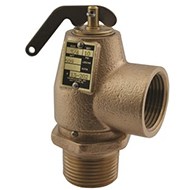Why You Need Relief Valves

The Importance of Relief Valves
A relief valve or pressure relief valve (PRV) is a type of safety valve used to control or limit the pressure in a system. If there is no means of relief, the pressure can build up and cause process, instrument or equipment failure, or fire. Relief valves can and should be used in many systems, but for now we are going to talk about boilers.
As the steam pressure within a boiler approaches the set pressure of the valve, the valve begins to react. When pressure equilibrium is passed, a disc inside the valve starts to lift off its seat. The moment this happens, steam is suddenly released all around the disc to what is called the “huddling chamber.” This chamber increases the area of the disc that sees steam pressure, thus increasing force. This increased area under steam pressure makes the pressure much more unbalanced and opens the valve to relieve the pressure. Closure of the valve occurs only after the boiler pressure is dropped several pounds below the set point.
Proper installation of a steam relief valve is somewhat simple as long as two areas of concern are followed:
The first area of concern is valve distortion. Valve distortion occurs when the valve is improperly wrenched in, using the valve body instead of supplied wrench flats. Distortion also occurs when the discharge side of the safety relief valve is made to bear the weight of the discharge piping. To prevent this distortion use a short nipple from the valve to an independently supported bell reducer or drip pan elbow. These valves are precision devices and any distortion will affect accuracy and calibration.
The second area of concern is discharge piping. For a safety valve to do its job it must be sized properly to adequately relieve all the steam the boiler is capable of producing while operating at its maximum. All piping to or from a safety relief valve must be at least as large as the valve’s connections. Also, the restrictive effect of elbows and the friction losses in pipe must be taken into account. For this reason, piping runs should be as short as possible and pipe sizes should be generous.

